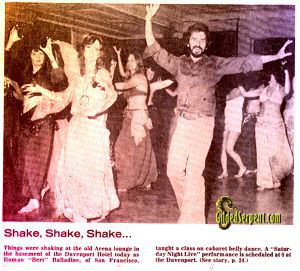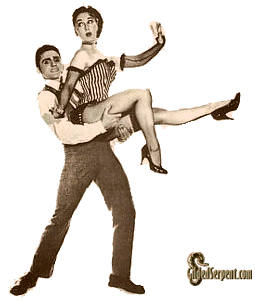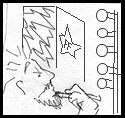Tale of the Rat
Beginning to Teach, Part One

by Najia Marlyz
posted April 16, 2013
He warned me! My German speaking mentor and dance partner, Bert Balladine, told me one day that teaching would change my dance—not necessarily for the better.
“I am warning you: Teaching will ruin your dance!” he said, shaking his head.
Still, when one comes to a crossroads where a decision must be made or an opportunity will be lost, sometimes it is better to chose courageously rather than second-guess yourself. “Reality will sink in soon enough; you will see that all the possible options that would have been the result of choosing another path will be lost to you,” he warned. However, I knew also that many paths intersect, and it is possible that sometimes a wrong choice may turn out to be instructive at the least and not so final as it may seem at the moment. In the long run, it may prove to have been the correct choice, even though it may not have been the easier road of the two.
Before our afternoon “kaffeeklatsch” conversation ended about my opportunity to begin teaching belly dance, I asked Bert to explain what he meant when he said that teaching would ruin my dance. Why would it be ruined and how? He explained that when you teach an art that you have infused with your personal passion and emotions from the core of your being, you will be tempted or even forced to intellectualize what you do and how you have achieved it. More often than not, that continual amount of intellectualizing actually can transform the finished dance into something unintended, destroying its essence. Your performance can become stilted by following your own procedures and following your own advice that you dish out day by day, lesson by lesson.
Additionally, Bert cautioned me that both words and methods used in teaching are constantly open to misinterpretation and to criticism by others who may have some personal agenda at stake.
How right he was! All teachers build upon the instructive methods of the teachers and performers from whom they have learned and been impressed. The gift of teaching doesn’t come through thin air from the grace of God—at least not usually. Information has to be learned and processed by widely different individuals, each with their own strengths and weaknesses. The mixture can become a hodge-podge of gargantuan proportions! Only a few teachers are talented with the ability to image subjects with simplicity, but simplicity is necessary to reach those students who learn through inner imagery, while at the same time, a teacher must demonstrate the movement for those who learn visually. Sometimes, a teacher may feel a need to resort to “breaking a movement down” into segments for those few who are not natural dancers and must do everything by drilling relentlessly and intellectual pursuit.
 In the few years I spent working in the public schools as a beginning elementary teacher, I had already experienced the vast differences that exist from student to student on their separate and individual paths of learning; so I asked Bert, “Well, then, what do you advise me to do now? Should I accept the contract to teach belly dance in the recreation department or not?”
In the few years I spent working in the public schools as a beginning elementary teacher, I had already experienced the vast differences that exist from student to student on their separate and individual paths of learning; so I asked Bert, “Well, then, what do you advise me to do now? Should I accept the contract to teach belly dance in the recreation department or not?”
“If you don’t, you may lose your opportunity and your momentum, so go for it, but remember to continue developing your performance level or your career will be a short one. A dancer’s career is limited enough already because your body will continue to change as you age. It will eventually get to the point where your body will fail if you continue to dance in the same way that makes you successful today.
What you can perform at age 25 will look ridiculous on your body at 35 and even worse at 45!
A dancer is always a work in progress; if you freeze your dance in time by laying down rules for teaching your dance at its present level, your students and perhaps, even you will not have its future essence to use as a way to express yourself. Also, you may find your own words, badly garbled, coming back to haunt you after passing down through several generations of dancers.”
Bert proved correct about that point! For lack of a proper name for a dance movement, back in the ’70s I named a certain hip action “The Piston Shimmy”, likening it to the movements of the pistons of a combustion engine moving sharply up and down on each side without any twist or front-back torque. Several years later, a workshop teacher manifested who was teaching the same movement, calling it a “Pistol Shimmy” and after only a few questions, we discovered that it had been taught to her by a teacher who had taken my workshop and misheard what I had named it. It had morphed, like the gossip in the old children’s game called “Rumor”.
How fortunate I was to have Bert’s encouragement as well as his cautionary words! He ended my original giddy fears of accepting the offer from the recreation department by telling me not to worry; he would help me compose my lessons. However, the truth of the matter is, when a person promises you help, he promises it within his own comfort zone rather than addressing the specific problems you might have in mind. It was evident that Bert was there for me as an advisor and a confidant, but he had no intention of teaching me how to teach others dance. Why should he? That is how he made his living and his life! It was enough that he encourage me to seize the moment and take my opportunity. Relaxing became difficult as my recreation department’s target starting date approached; so I began to do what was necessary when I was a teacher in the grade schools of Seattle, Washington: I created a series of lesson plans for the next twelve weeks and decided to figure it out for myself as time and the class progressed rather than taking it all on at once at the outset.
Bert came through on his promise of help through reviewing my proposed lesson plans. However, it was comforting to focus more attention to how he taught his lessons. I audited as many of them as possible and tried to see how he reached out to his students—what was successful and what kept students returning for another class. When I opened my Albany dance studio in 1973, Bert came across the bay and taught two weekly classes in my studio and invited me to audit them both. He advised me to sit, watch, and take notes, but said not to dance as a student in his classes, explaining that he was trying to help me build my career rather than continuing on with physical repetitions of the same old principles of dance he presented repeatedly. He said that if anyone wanted to be recognized as an instructor, one should stick to private coaching to improve rather than sweating it out with students who had not seen his information before, and of course, a beginning teacher should perform as often as possible. He was right, of course, if I had been dancing in his class, I would not have the opportunity to see the responses his students made to various things he said and the apparently bizarre things he challenged them to do to loosen their personalities in front of onlookers.
Bert was masterful in his use of imagery and humor. He told stories in metaphors and anecdotes. He had his students laughing and imagining almost silly scenarios, in order to reach the level of relaxation that belly dance requires in order to be both artistic and entertaining at the same time.
He demanded that his dancers never become so “artsy-fartsy” (as he put it colorfully) that they forgot that they were, first and foremost, entertainers.
 When asked about his use of stories, some of them personal, some fantasy, some of them totally ridiculous, he explained that he used them to make the dance principle and stagecraft he was teaching that particular day memorable. Memorable they were, especially when it came to the ethics of show business backstage or to the business of creating one’s “niche” in the world of dance instruction! Some of those little stories were priceless and funny, and carried a message that could prove useful to performers. Everyone giggled or chuckled about the stories and said how fun Bert’s classes were, but not everyone was prepared to understand that Bert’s wild stories were a major part of his instruction for professionals.
When asked about his use of stories, some of them personal, some fantasy, some of them totally ridiculous, he explained that he used them to make the dance principle and stagecraft he was teaching that particular day memorable. Memorable they were, especially when it came to the ethics of show business backstage or to the business of creating one’s “niche” in the world of dance instruction! Some of those little stories were priceless and funny, and carried a message that could prove useful to performers. Everyone giggled or chuckled about the stories and said how fun Bert’s classes were, but not everyone was prepared to understand that Bert’s wild stories were a major part of his instruction for professionals.
One story he told still tickles me to this day, and I will share it with you now, even though it will not be in context and may not express the chemistry of the moment that it had back then when he told it. He told his personal story with charm and a lilting German accent. This was the story of the black eyebrow pencil that he kept on the top of his performance make-up case backstage where he was dancing a duet nightly with his wife of the time—a German movie starlet.
It was important in stage makeup in those days to outline ones lips with a thin black line made by the sharp point of an eyebrow pencil in order for the expression of the mouth to be seen at all from a large distance on stage and under harsh stage lighting. He said that his wife (and dance partner of the time) was continually wearing down the tip of his black pencil after he had used it. He complained that she was always breaking it off carelessly so that he had to keep buying new ones after sharpening the old one every day until it was down to a nub. The two of them argued repeatedly about the pencils, but it was never very important to either of them; it was simply irritating.
One evening as they left the theater, Bert remembered that he had left his jacket hanging on the chair in the dressing room, and he quickly ran back for it. As he switched on the light, he surprised a huge brown rat, (It was this big, he gestured, holding his hands about a foot apart.) sitting up on its haunches, holding his black eyebrow pencil between its front paws, nibbling on it with little yellow teeth—the point already chewed down nearly to the wood. All of us winced, chiming together, “Eu-w-w!”
After once hearing Bert’s "Tale of the Rat", I could never teach my new performers their stagecraft without retelling his rat story. The lessons in Bert’s tale of the rat were:
- Always clean up, close up, and lock up your belongings backstage and never accuse your fellow performers of misdeeds when you have to work in harmony with them night after night.
- Wear much darker lipstick when you are performing than you would normally wear in your off-stage life, because harsh lighting and distance does strange things to a dancer’s face.
 |
 |
 |
 |
Resources:

Have a comment? Use or comment section at the bottom of this page or Send us a letter!
Check the "Letters to the Editor" for other possible viewpoints!
Ready for more?
- Teacher or Coach: What’s the Difference? Why All Performing Dancers Need a Dance Coach
Most performers have a great deal of untapped potential; additionally, many consider it cheating to engage a professional coach and yet, that is exactly what they would look for if this were the Olympics and they were competing for the gold! - 6-19-09 The Dance Teacher: By Divine Design or Default?
…nearly everywhere, dancers in this particular form seem to have found it necessary to “do it all” in order to earn a living by dance career alone. - 11-28-06 Back to Basics
Belly Dance is most meaningful when we define it as a communication of mutually held emotional response and truths between people. - 10-19-01 Follow the Bouncing Butt; in Defense of a Teaching Method
Some of the "Follow Me" teachers should be more aptly described as "inspirationally oriented". - 8-11-00–Yasmina’s First Club Gig
"You’re so beautiful! Wouldn’t you like to audition to dance for us?" - 10-19-99 Belly Dancer Paper Doll
Print this paper doll. Then color, cut her out and PLAY! - 2-99 Fabulous Fritz’s Adventures in Show Biz. Adventure #1
"I’m just a photographer, I don’t know these women!" - ? -99 Fabulous Fritz’s Adventures in Show Biz #2
"I have just enough time to drive back…" - -9-13 The Third Annual San Jose Showcase for Gothic Dance, The Third Annual Lumen Obscura, April 5-6, 2013, Hoover Theater, San Jose, California
Here are some of my favorites from both the Mayhem Matinee (afternoon show) and the Shiver N Shake Showcase (evening show). "Lumen Obscura is a NorCal annual Dark Fusion & Theatrical belly dance event that showcases some of the best in the genre". Produced by Deidre Anaid. - 4-4-2013 Old Scholl Stardom Shines in a New Land, Tito’s First Visit to Taiwan
No matter how much splendor and glamor is presented on stage, bellydance should always preserve the fundamental spirit and vision of the culture. So he prefers to create a homey atmosphere to remind the audience that dancing and singing at a family gathering is also an essential feature of Middle East performance arts. - 3-28-13 Is the Bedlah from Hollywood?, The Origin of Our Costume
As long as I can remember, the origins of the bedlah (the two piece costume of Middle Eastern dancers) has been widely controversial and debated among the artists of Raqs Sharqi (belly dance). The dance itself, along with the costume, has gone through many centuries of changes and name identifications in accord with period fashion as well as contact with outside influences.
3-26-13 Southern Cal’s “Shira” Reminisces Dancing in Los Angeles Nightclubs in the ‘70s and ‘80s
In the late 1970s and early 1980s, along with the multiple Arabic clubs in Hollywood, there was also a thriving Greek, Armenian and Persian nightclub presence in the Los Angeles area. Shira (Jane Padgett) was a popular dancer in those clubs and is still a popular working dancer in Southern California. In this business, there are the dancers with a presence in the dance community due to participation in showcases, competitions, teaching and self-promotion,and additionally, there are the "workhorses", those who slogged away at the clubs, entertaining the masses for years and years, flying under the radar.
Sierra
Apr 28, 2013 - 04:04:30
Thanks Najia:
I love hearing your memories of Bert and his personal style of wisdom and creativity. How well I remember taking classes from him at your Albany studio, and he was a step above any other teacher I had taken from…he really watched each student in the class…and when making a critique, did so in a way she would understand, but with a bit of a joke attached to it so they weren’t embarassed. He also gave individual praise. I liked that he emphasized how to look like “ladies”, etc. HE was a wonderful person, with his idiosyncrisies….
IT’s great to hear you recount his life.